Today, we headed up to the highest part of our journey, crossing the most mountainous part of the journey since the Pyrenees. I got a late start at 8:30 a.m. since I had a hotel room and wanted to sleep in a bit. Leaving about an hour later than usual made for a very long day.
I walked through Rabanal del Camino in the early morning light, passing the monastery where I read during Vespers last night.
The first 5.3 km to Foncebadón was on a path zigzagging through a wood of oaks and holm oaks, and lined with frost-covered ferns and gorse, as well as Mormon Tea. I enjoyed magnificent views across the Turienzo Valley towards Monte El Teleno.

Rabanal del Camino to Foncebadón

Rabanal del Camino to Foncebadón

Rabanal del Camino to Foncebadón

Rabanal del Camino to Foncebadón
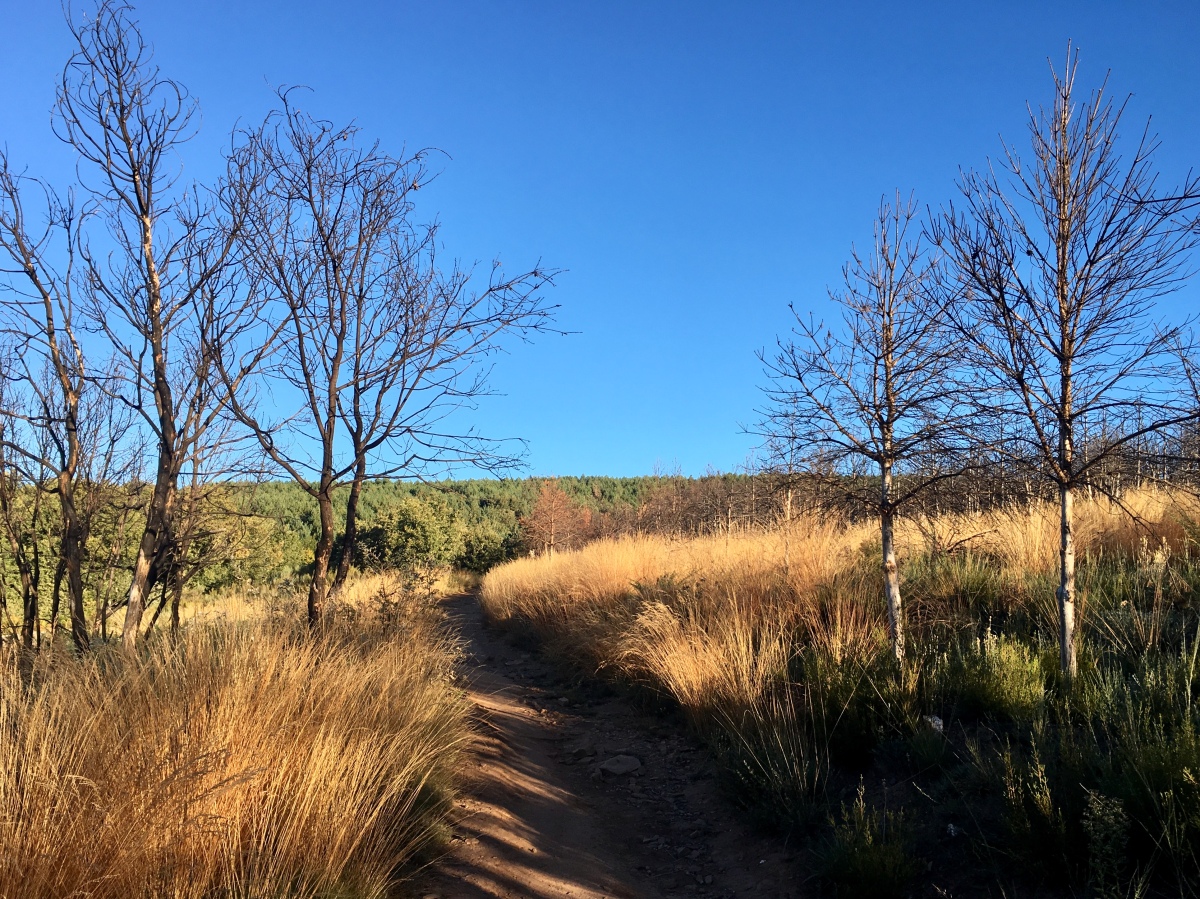
Rabanal del Camino to Foncebadón

Rabanal del Camino to Foncebadón
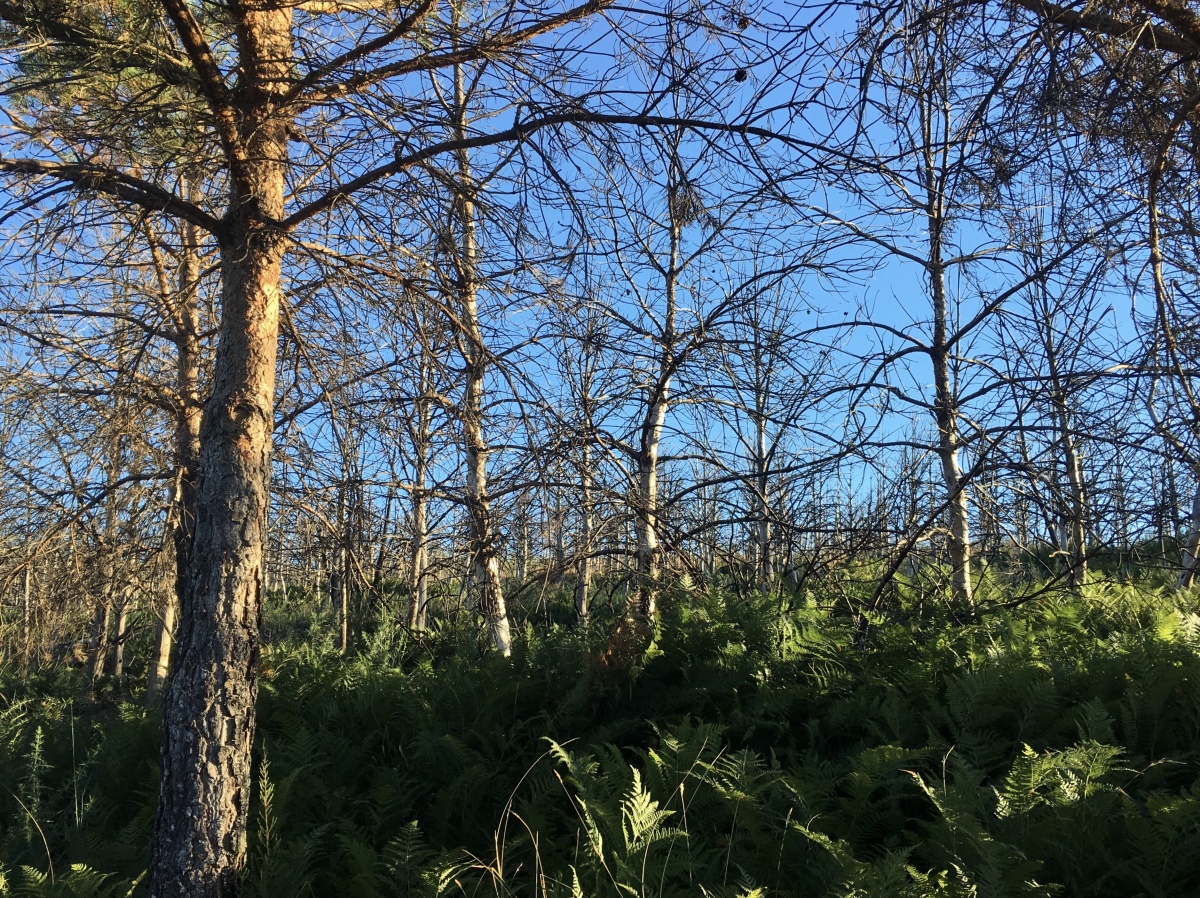
Rabanal del Camino to Foncebadón

Rabanal del Camino to Foncebadón
We climbed ever upward, constant and hard with few rest spots, to Foncebadón, a funky little town with crumbling buildings and cool bars playing a great array of music. The town was home to the 12th-century hermit Gaucelmo, who built a church and simple pilgrim hospital here. Apparently some of the crumbling buildings are now undergoing renovation.
Rabanal del Camino centro to Foncebadón (5.3 km)

cattle near Foncebadón

horses near near Foncebadón
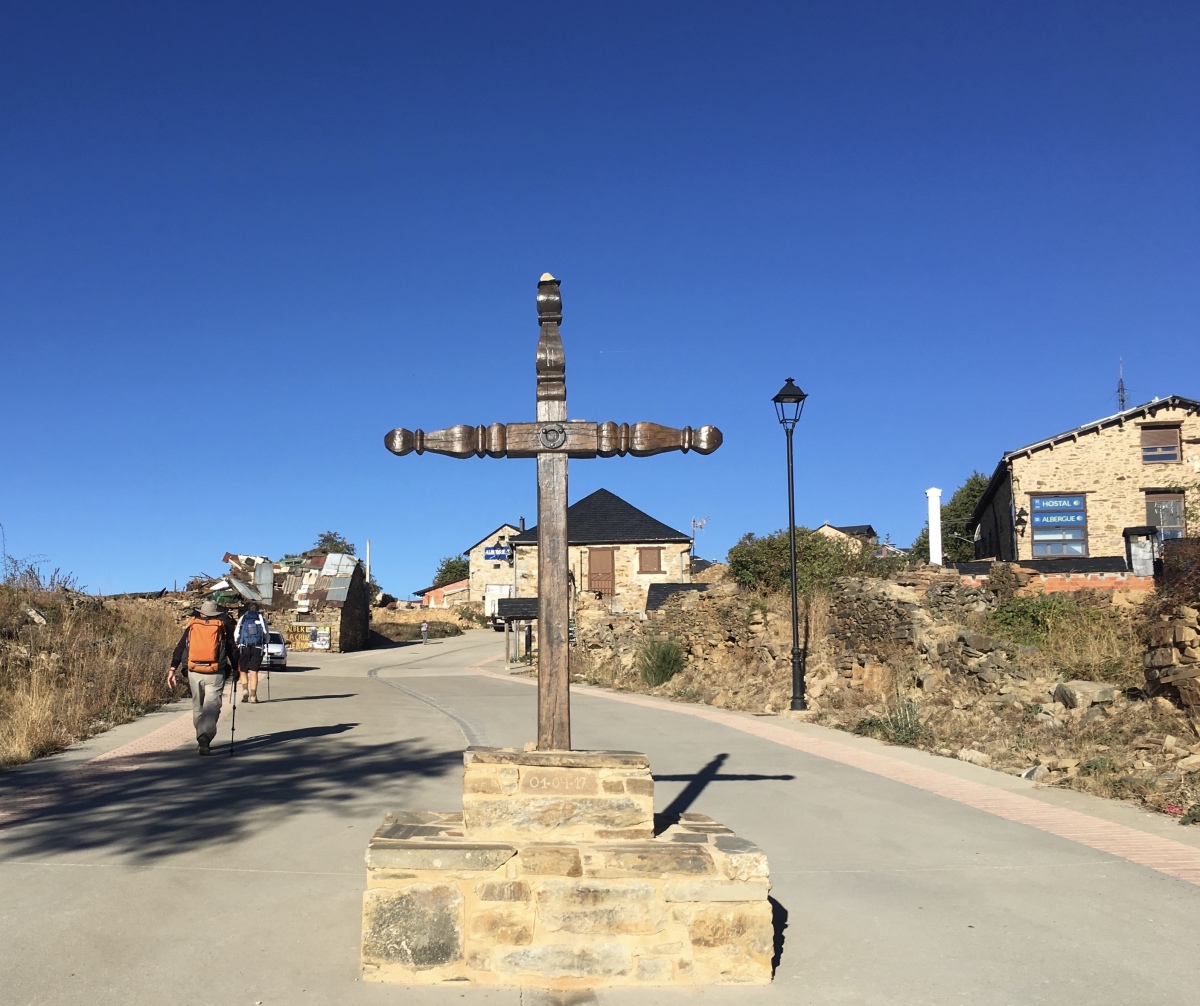
Foncebadón

the crumbling town of Foncebadón

crumbling Foncebadón

distances from Foncebadón in the village cafe

church in Foncebadón
From the top of the town it would be only 2km more to the highest point at Cruz de Ferro. The first section was a stiff climb.
Foncebadón to Puerto Irago (Cruz de Ferro) (2.0 km)

Foncebadón to Puerto Irago

Foncebadón to Puerto Irago

Foncebadón to Puerto Irago

Foncebadón to Puerto Irago

Foncebadón to Puerto Irago

Foncebadón to Puerto Irago
Cruz de Ferro is a simple iron cross atop a weathered pole that stands at 1,504 meters above sea level, the highest point on the Camino. The cross is not the original one, but replaces another whose origins were many years distant; this was originally the site of a Roman altar dedicated to the god Mercury. At the base of the cross is a large mound of stones left by pilgrims.
The custom is for a pilgrim to bring a stone from home. It is symbolic of deliverance from sin offered by the pilgrimage. Supposedly, you place all your burdens on the stone and lay it at the foot of the cross. In recent times, many stones come from just a few meters away, and travelers have taken to leaving votive offerings, making the base of the cross a bit untidy.
On the site is a modern stone chapel, Ermita de Santiago, built to commemorate an earlier holy year; it stands locked at the site.
Some bicyclists got to Cruz de Ferro before me and took their bicycles up to the cross for photos. Several pilgrims were upset by this and complained that they were being disrespectful. One woman said, “Would you put your bicycle on an altar?” The bicyclists disagreed so there was a bit of an argument, which ruined the mood. One guy was impatient to take a video for his mother. Other people kept climbing around and posing and then a tour bus drove up. It was not the experience I had hoped for.

Cruz de Ferro

Ermita de Santiago
I had picked my stone up from atop the Pyrenees and carried it to this point. My stone carried many burdens including my many character flaws, my fears and worries, my intolerance for people of certain political views, my strained family relationships and so much more. I laid all these things down at this cross, trying to turn all these burdens over to God. It was quite moving but not as moving as I hoped it would be.
I placed onto that stone my worries about my children: about their struggles to become independent and self-supporting, to feel secure and loved, to find joy. I asked for healing in my relationships with all of them. I knew they didn’t trust me or count on me, and I couldn’t blame them. For Mike, I put my sorrow over breaking his heart during our seven-year separation. I asked for self-forgiveness. I gave gratitude for his love and support and the life he’s given me.
I tried my best to put aside my intolerance for all the people in America who voted Trump into office. I asked for healing for my anger, even though I didn’t really want to let it go. I felt by forgiving them I could become complicit, like silent Germans during the Holocaust. I wanted to stop worrying about the world and my country in the age of Trumpism, Brexit and all the hatred and intolerance that has been unleashed in the world; I wanted to forgive all greedy and power-hungry people. I put on that stone worries about the daily chipping away of our democracy.
I hoped to let go of worries I had about what people thought of me, whether they hated me or disliked me or wanted to judge me for what I’d done in my life.
I put on that stone my bitter feelings toward my mother and father, because I carried so much anger that they never have been the parents I wanted. I tried to put on that little stone too much really: all my anger, frustrations, feelings of being out of control, my lack of trust in God, my lack of faith, my selfishness, my aloofness. My fears and intolerance and my judgments. I tried to put aside my feelings of superiority and my dishonesty.
I asked for simple trust and faith, and for a deeper spiritual connection to God.
After leaving Cruz de Ferro, we walked across the mountaintop for some distance, and made our way on a well-kept walkway to a brief stop at Manjarín, a kind of mountain sanctuary offering basic facilities, souvenirs and snacks for a donation. Other than the quirky hostel, the village is abandoned and in ruins. The pennants and crosses bear witness to the efforts of the hospitalero to revive the tradition of the Knights Templar. Another icon is the post with numerous wooden signs indicating the distance from this spot to other points on the planet.
Puerto Irago (Cruz de Ferro) to Manjarín (2.4 km)
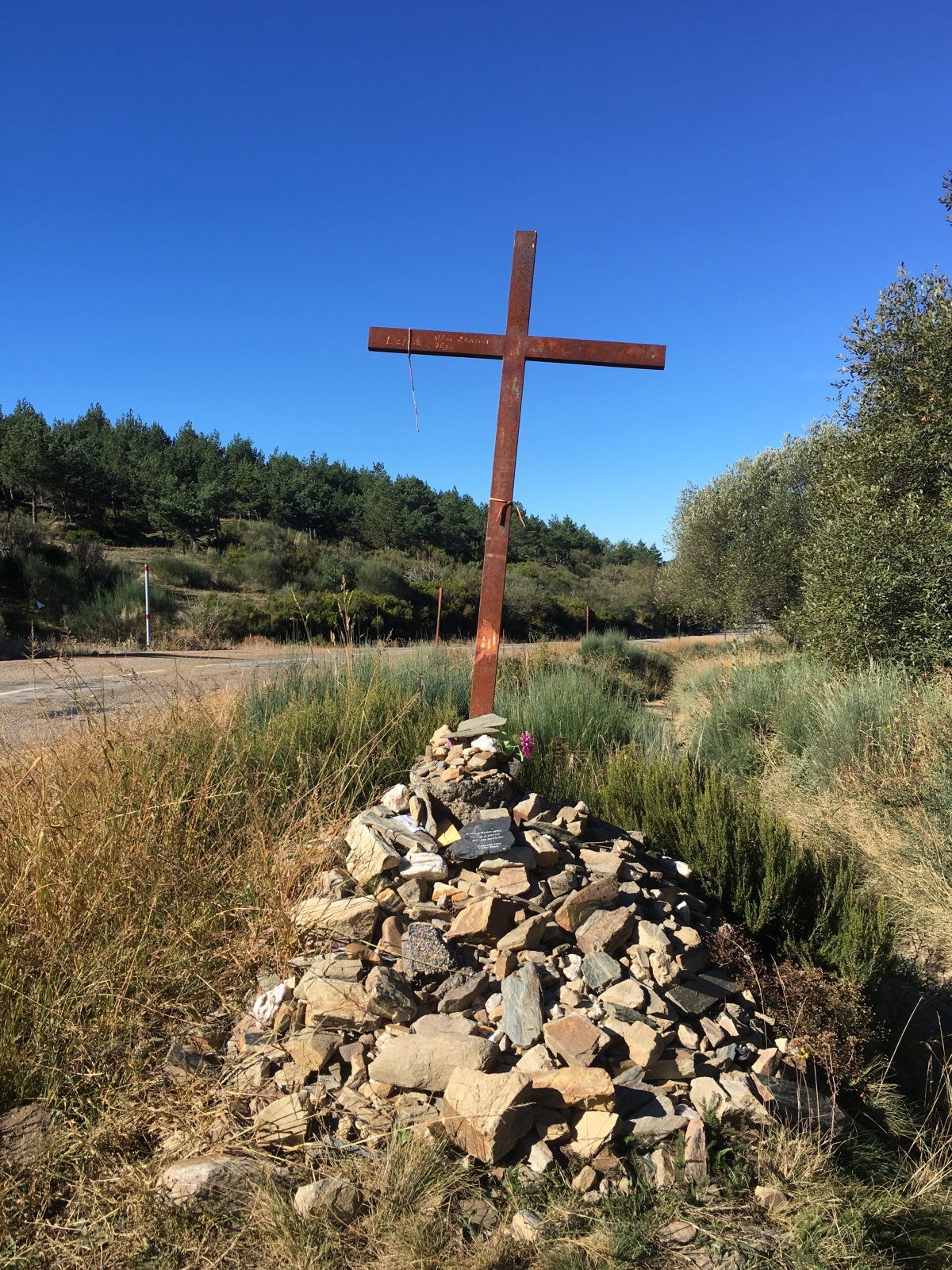
Cruz de Ferro to Manjarín

words from Rumi

Cruz de Ferro to Manjarín

Cruz de Ferro to Manjarín

Cruz de Ferro to Manjarín

approaching Manjarín

Manjarín

Manjarín

Manjarín

Manjarín

Manjarín
From Manjarín, we took a mountain path which led steadily upward to a pass forested with communication towers and a military base. I loved seeing the windmills on the ridges around us and the pink gorse lining the path. Soon we began the long and steep descent into El Acebo on a stony path, very punishing on the knees.
Manjarín to El Acebo (6.8 km)

Manjarín to El Acebo

Manjarín to El Acebo
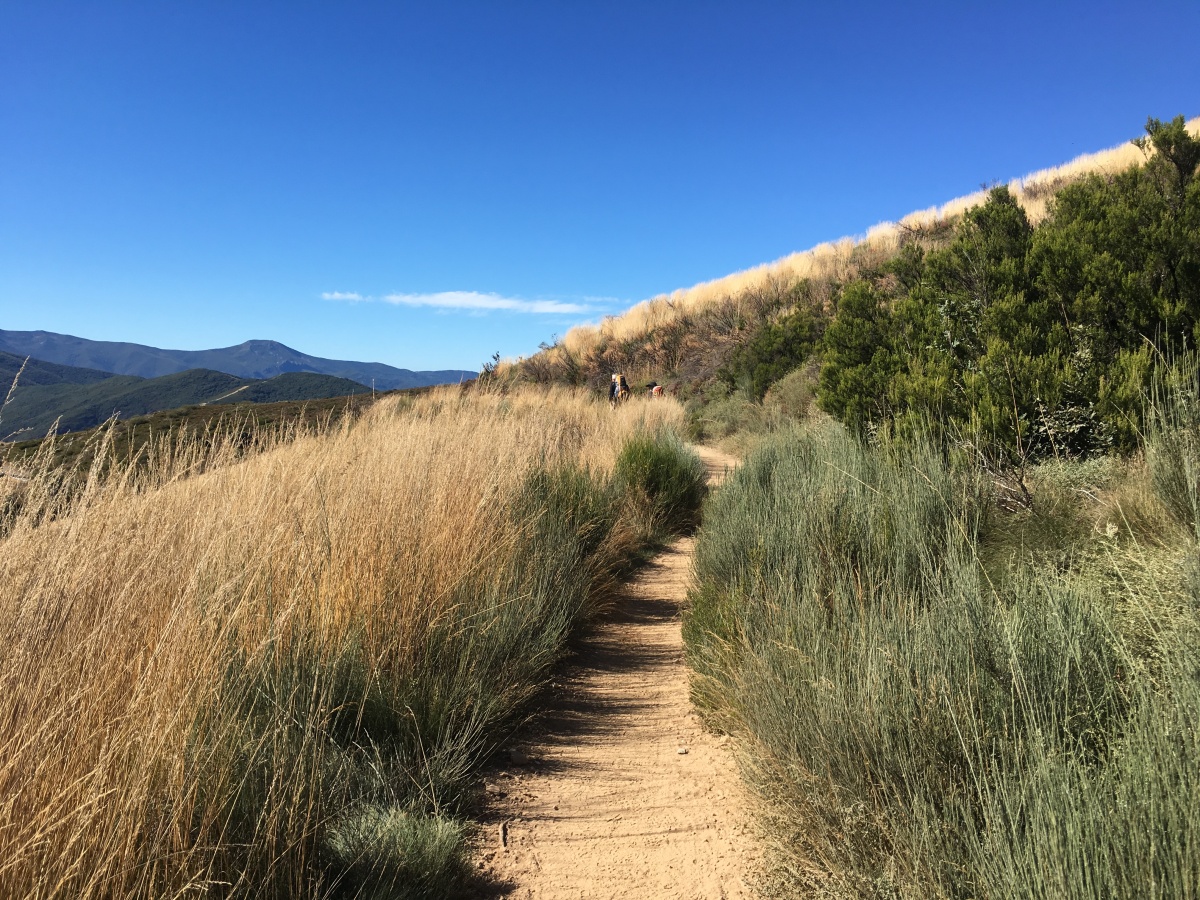
Manjarín to El Acebo

Manjarín to El Acebo
The walk down to El Acebo was long and grueling – a steep descent over rocky terrain that seemed to go on forever. I was exhausted from concentrating so hard every step. I was thankful for my Leki hiking poles.

steep descent to El Acebo
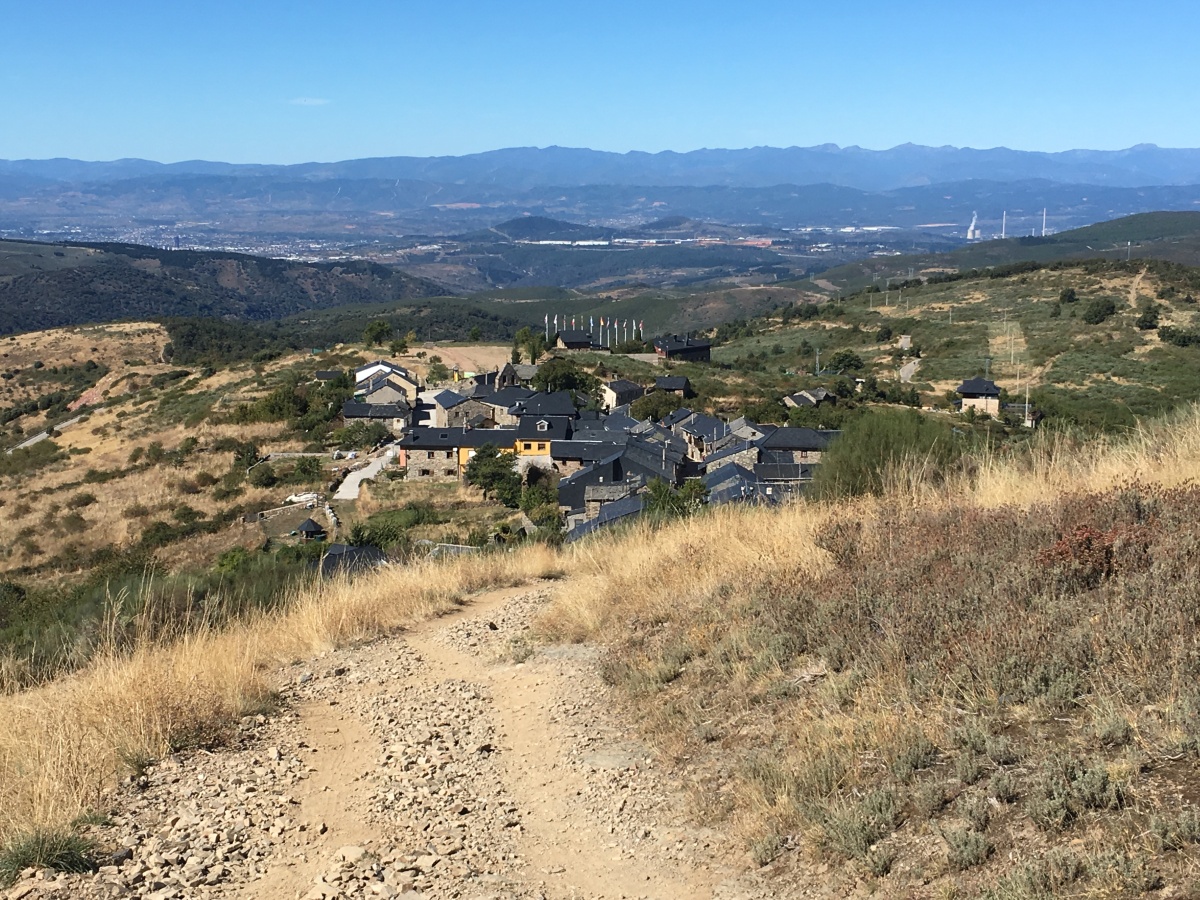
steep descent to El Acebo
El Acebo is a small but well-kept town, with most houses restored. The typical mountain village has one main street running through the middle. Ancient agricultural implements decorate the streets. At the far end of the village is a modern sculpture of a bicycle outside the village cemetery, a memorial to a pilgrim killed on the road here. The parish Church of San Miguel has a statue of Santiago Peregrino.
The albergue at the far end of town, La Casa del Peregrino, was modern and well-fitted. I could have used a hamam there but I didn’t. I did get a hot oil massage from an Indian guy from Kerala. It was full body massage with no holds barred. It was a bit disconcerting as American massages are so prudish. The massage was quite fast moving so not really that relaxing, but it was okay.
I had three roommates, all women, in an 8-bed room: Lorna from Finland, Ingrid from Holland, and Ellen from Germany. I didn’t care for Ellen or Lorna at all. Lorna was very outspoken about everything and kept calling me Katie; she was always talking but never listening or asking questions. Ellen was the fashion designer I’d talked to briefly the day before, the who who left me in the dust when a handsome man walked by. I overheard her talking to the others about how to get rid of people you don’t want to walk with (say you want to take pictures, or you want to rest or take a nature break). The way she’d shed me earlier was to say she needed to speed up her pace (to catch up with a man). Both of those women seemed shallow and superficial to me.
The only one I liked was Ingrid who seemed down-to-earth but was hooked up with Lorna so I just avoided them all and kept my distance.
The worst was how Lorna talked about how much she loved the whole journey and talking to other pilgrims, yet she was so rude to me. I basically gave her the brush off too. Ugh. Some people. Obviously I didn’t fully let go of my intolerance with the rock I left behind at Cruz de Ferro.
At dinner, Lorna demanded in a bossy voice that the waiter turn off the television in the common room. I didn’t care for her at all.
The pilgrim meal was good, gazpacho with toppings of pepper and croutons, a potato tortilla with chorizo, and strawberries with whipped cream.

gazpacho with toppings of pepper and croutons
I would have to get an early start in the morning to avoid having to walk with these abrasive women.
Ruminations {week five}
During my fifth week, I passed through León and Astorga, both stunning cities dominated by large cathedrals. Each city also featured a Gaudi building, Museo Gaudi Casa de Botines in León and Palacio Episcopal (Bishop’s Palace) in Astorga. I passed crosses woven into chain link fences over busy highways, treeless plateaus, and bodegas, or underground wine cellars. Sometimes I walked alongside busy highways with trucks and cars roaring past and nothing much of interest to see. There was little charm to be found in most small villages.
Some days seemed endless, so I tried hard to keep my eyes down and stop hoping for a glimpse of the town. I know in life, that’s like wishing your life away. I drank water to keep cool on hot, shadeless tracks, sat down to rest where I could, looked at cornstalks and dandelions and spiky weeds and butterflies, white and yellow, fluttering about. I even enjoyed short stretches of shade.
The nineteen arches of the Puente de Órbigo carried me across the Río Órbigo. Walking across, I heard the murmur of the running water, birdsong, and a breeze tickling the nearby poplars. The terrain changed to rolling hills of farmland dotted with trees. We crossed into Galicia.
The little village of El Ganso was crumbling, partially in ruins, making it charming and picturesque. We headed up to the highest part of our journey, crossing the most mountainous part of the journey since the Pyrenees. We climbed ever upward to Foncebadón, a funky little town with crumbling buildings and cool bars playing a great array of music.
I laid my stone at Cruz de Ferro, a simple iron cross atop a weathered pole that stands at 1,504 meters above sea level, the highest point on the Camino. At the base of the cross is a large mound of stones left by pilgrims.
The custom is for a pilgrim to bring a stone from home. Supposedly, you place all your burdens on the stone and lay it at the foot of the cross. I laid my stone with its many burdens, which I had picked up atop the Pyrenees, at the foot of the cross. I tried to turn all them over to God. I asked for simple trust and faith, and for a deeper spiritual connection to God.
The walk down to El Acebo was long and grueling – a steep descent over rocky terrain that seemed to go on forever. I was exhausted from concentrating so hard every step. I was thankful for my Leki hiking poles.
I started experiencing extremes of temperatures, with cold mornings and warm afternoons. The nights were becoming colder and my sleep more restless.
I continued to enjoy Spanish food along the way, but the cuisine was changing. I ate a lot of lentil soup, albondigas and fries, and the ever-present vegetable tortillas. I ate morcilla, or blood sausage, with my friend Darina in León. In Hospital de Orbigo, I ate trout soup, a local specialty, that had way too much bread in it! I also tried garlic soup, with too much bread again, trout, fries and flan. I ate green beans, vegetable & bean soup, and cheesecake for dessert. I enjoyed a cool limon y cerveza with many meals, and of course all the wine we could drink.
In Astorga, Darina and I went to a fancy restaurant where we looked like something the cat dragged in. The country bumpkins had come to the city. We shared a delicious chickpea and wild mushroom soup. We ordered beers which the waiter poured into the wineglasses. We laughed and joked that most people probably didn’t drink beer at this place. We also shared the local dish, cocido maragato, typically a hearty meat stew – pork and black pudding with beans and cabbage – followed by vegetables and finished off with a bowl of broth. Our meal was a little different. The dish had pork, sausage, ham, beef, chicken, and some kind of heavy bread dumpling. The second course was chickpeas with cabbage, deliciously seasoned. We enjoyed pudding for dessert. And we shared lots of laughs, as we always did.
El Ganso had a funky Cowboy Bar, but the highlight of the town was a tiny supermarket where I got toast with chopped tomato spread and sliced avocado drizzled with olive oil.
The people I encountered on this stretch of the Camino included Darina, who had caught up with me after spending five days in Navarette, and dust-covered Mark from the Lake District in U.K. who now lived in Spain and was walking 45 km per day; he had divorced his wife but was still friends with her and was walking the Camino to figure out what he wanted. I ran into Sheryl, Sharon and John, the threesome traveling together, too many times to count. Phil from Britain irritated the crap out of me with his know-it-all-attitude and his bigoted views. I met Coreen, from Oregon, with whom I didn’t feel a close connection, and two fun-loving Irish sisters, Marian and Anne. We talked of everything from our sons and young men in general to politics – Trump and Brexit – and our Camino experiences.
Darina and I didn’t think the movie, The Way, was realistic, especially the part about those four characters randomly meeting and then walking together the whole way. We agreed that such a scenario was unlikely. However, we did think of a few people we met that did join together for the duration, like Australian Karen and Taiwanese Chun-Yu.
I shared a room with Ellen from Germany, Lorna from Finland, and Ingrid from Holland. I didn’t care for Ellen or Lorna at all. Lorna was very outspoken about everything and kept calling me Katie; she was always talking but never listening or asking questions. The only one I liked was Ingrid who seemed down-to-earth but was hooked up with Lorna so I just avoided them all and kept my distance.
I enjoyed a hot oil massage from an Indian guy from Kerala. It was full body massage with no holds barred. The massage was quite fast moving so not really that relaxing, but it was okay.
What I loved the most was meeting up with Darina for dinners and lunches, and meeting the two Irish sisters. I loved reading at Vespers in the Monastery in Rabanal del Camino. I adored León, Astorga, and the charming oasis outside of León, La Casa del Camino: Albergue de Peregrinos. Though it sat along a busy road, lounge chairs and couches dotted the green lawn, hammocks beckoned under a merry-go-round like canopy, a line of foot baths offered pain relief, and the owners welcomed pilgrims with fresh orange juice.
What I hated was meeting with certain abrasive people and the extremes in temperatures.
Luckily, during this stretch, all was quiet on the home front, and I didn’t hear about any ordeals involving my children or family.
**********
*Day 35: Monday, October 8, 2018*
*32,252 steps, or 13.67 miles. Rabanal del Camino to El Acebo (16.5 km)*
You can find everything I’ve written so far on the Camino de Santiago here:
**************
On Sundays, I post about hikes or walks that I have taken in my travels; I may also post on other unrelated subjects. I will use these posts to participate in Jo’s Monday Walks or any other challenges that catch my fancy.
This post is in response to Jo’s Monday Walk.





















Some of the countryside is so very tranquil and beautiful, Cathy. So much hope invested in that little stone! The one person in life we can never escape is ourselves. Sometimes that feels like a punishment to me. Just occasionally it is a joy. 🙂 🙂 Thanks for sharing, hon.
LikeLiked by 1 person
Good point Jo and I agree. Cathy, TV’s in cafes and nearly everywhere in Portugal and Spain were a bugbear for me. as it made for a not so relaxing meal with a blaring TV. The scenery is very picturesque on this section, made more so with the hills?
LikeLiked by 1 person
Yes, Suzanne, the TVs in cafes got to be rather annoying, for sure. The scenery here was very picturesque. Sadly, that wasn’t always the case, but mostly I’d say it was so. Hills make for prettier scenery but for harder walks, that’s for sure. 🙂
LikeLiked by 1 person
Yes, this part of the Camino had so much tranquility. This wasn’t always the case. Yes, since I was walking the Camino, I figured I might as well take up the traditions of laying your burdens on a stone. And you’re right, we can never escape ourselves. It is both a joy and a burden, sometimes one more than the other, depending on the day. Thanks for stopping by, Jo. 🙂
LikeLiked by 1 person
That was quite a day for reflection and introspection, and in an arid landscape, hard work
LikeLike
Yes, Sue, it was quite a day for reflection, meant to be so by tradition on the Camino. 🙂
LikeLiked by 1 person
Oh, OK😊
LikeLiked by 1 person
I’m in awe of your honesty as you lay yourself on the stone: I suspect you’re very hard on yourself, but that’s probably par for the course with self knowledge. A pity the high-point cross was so crowded, and that your expectations of being moved weren’t quite met.
I’m surprised again by the pleasantness and solitude of many of the pathways. I was drawn to the same thing revealed in the U3A talk I mentioned. Very unlike your experience: a search for French heritage in a small group, bused between places of interest – cathedrals, countryside, cloisters, bridges – not really a pilgrimage at all, and not even excessive walking.
You’ve inspired me again, this time to think about my own stone. I suspect it won’t be a pretty picture, once it’s loaded with the things I’d like to get rid of in myself.
I enjoyed your summarising ruminations: have you done this before and I missed it??? Not an unlikely scenario: I accused my son of removing my bootlaces and later discovered them in the boots, just not through the top hole!
LikeLiked by 2 people
Thank you, Meg. I wanted to try hard to follow the tradition on the Camino of putting my burdens on the stone and laying it at Cruz de Ferro. I tried to give it serious thought, although I suspect I’d done plenty of thinking along the long walk, and maybe that was why I didn’t feel so moved by the whole thing. Interesting that the talk you heard was such a different experience. I suspect it is the case for everyone; all experiences are so different.
As for the summarizing ruminations, I’ve done one at the end of every seven days. Just a kind of overview, mainly for myself, but for others too who care to read; it gives a broad overview instead of getting bogged down with details. I planned to only write weekly summaries from the beginning, but then I had too many photos I wanted to share from each day. 🙂
LikeLike
Have I been missing ruminations?? Maybe I’m losing it. I thought Joe said he wanted to talk to our daughter about unicorns the other day. He wanted to talk about uni course!
LikeLike
Maybe you have missed ruminations. If you missed the 7th, 14th, 21st, and 28th days, you would have missed them. That’s hilarious about the “unicorns!” 🙂
LikeLike
This day seemed more beautiful to me than some of the others recently, though that descent looks exactly the sort of path I hate. Steep, stony and slippery – far worse to go down than up. I don’t often walk with poles because my clumsiness makes them just another thing to trip over, but I think I might have to start. As for the stones at the cross, you bared your soul there and I hope it received some balm. Some people should have put on their stones learning to be respectful and allowing other people a share of the experience!
LikeLiked by 1 person
The descent on this day was very rough, Anabel. It was a beautiful walk early on, but that descending path into town was so steep and slippery. Thank goodness for my hiking poles or I certainly would have hurt myself. I had a good intention of laying my burdens on the rock, but it turns out those things we want to get rid of seem to stick with us, no matter how often we try to get rid of them. 🙂
LikeLiked by 1 person
Anabel and Meg have said what I was thinking. I think it is a good idea for all of us to have a self-assessment occasionally. But don’t be too hard on yourself Cathy. Maybe take the time to consider all the wonderful things you have / had in your life?
LikeLiked by 1 person
Yes, Jude, of course I do have many wonderful things in my life, and I greatly appreciate them all! However, this tradition called for putting burdens on the rock, and leaving the rock behind, symbolic of leaving behind those burdens. Thus I tried to be serious and give it a lot of thought. 🙂
LikeLike
I understand that. If only it was so easy for us to leave our burdens behind. I am afraid that we carry them with us for ever. Sadly life is not perfect and we all make mistakes.
LikeLike
I think it’s good to do an honest inventory from time to time, Jude, but honestly, I think it is very difficult to change those aspects of our personalities that are not the best. 🙂
LikeLiked by 1 person
They are I suppose what makes us us.
LikeLike
I suppose they are!
LikeLiked by 1 person
Did it ever begin to feel like this journey would never end? Perhaps on hard days, but when you had so much glorious scenery to enjoy it must have been easier.
LikeLike
Many times it seemed the journey would never end, Carol, but overall, I tried to take it a day at a time and not think too much about the journey ahead. It was always nicest when I had interesting company, or when the weather was cool and the scenery beautiful. 🙂
LikeLiked by 1 person
[…] (Camino day 35) Rabanal del Camino to El Acebo & ruminations (week 5) […]
LikeLike
What amazing pictures: i love the blue, blue skies. My husband used to call these “bluer than a boss-eyed carpenter’s thumb” which I think is an old London expression.
On your stone-laying, I must make a comment. First is that I don’t believe in this laying-off of sins, jealousies, angers etc., and second is I don’t think you should lay them off anyway. I think we need to keep the anger, to keep the sense of resentment, and to keep the impetus to change society that is the normal outcome, or result, of having these feelings. Stop blaming yourself, let others share the blame, but if you feel you are more to blame than others, well, it’s over now, move on, forgive yourself and say you’ll do better in future. But only if you seriously think you are mostly to blame. And don’t put your faith in a stone!
LikeLike
Well, Mari, I was trying to do the traditional thing and think seriously about the burdens I should put on the rock and leave them behind. I thought it was good for me to do an honest look at myself and the things I’d love to change. However, things are not so easily changed as that, but it was an interesting exercise anyway. I didn’t really put my faith in a stone! That would have been rather silly. 🙂
LikeLike